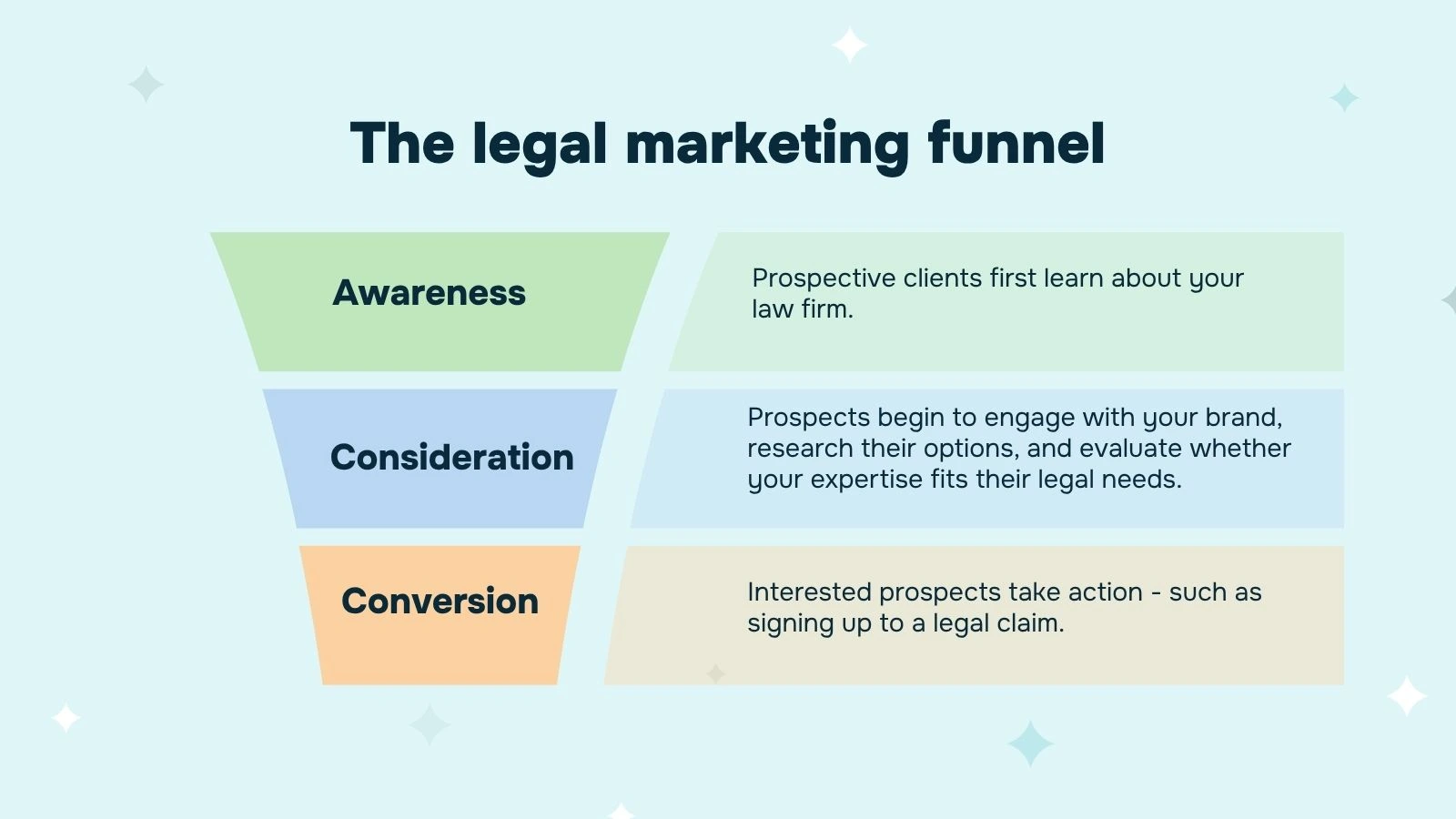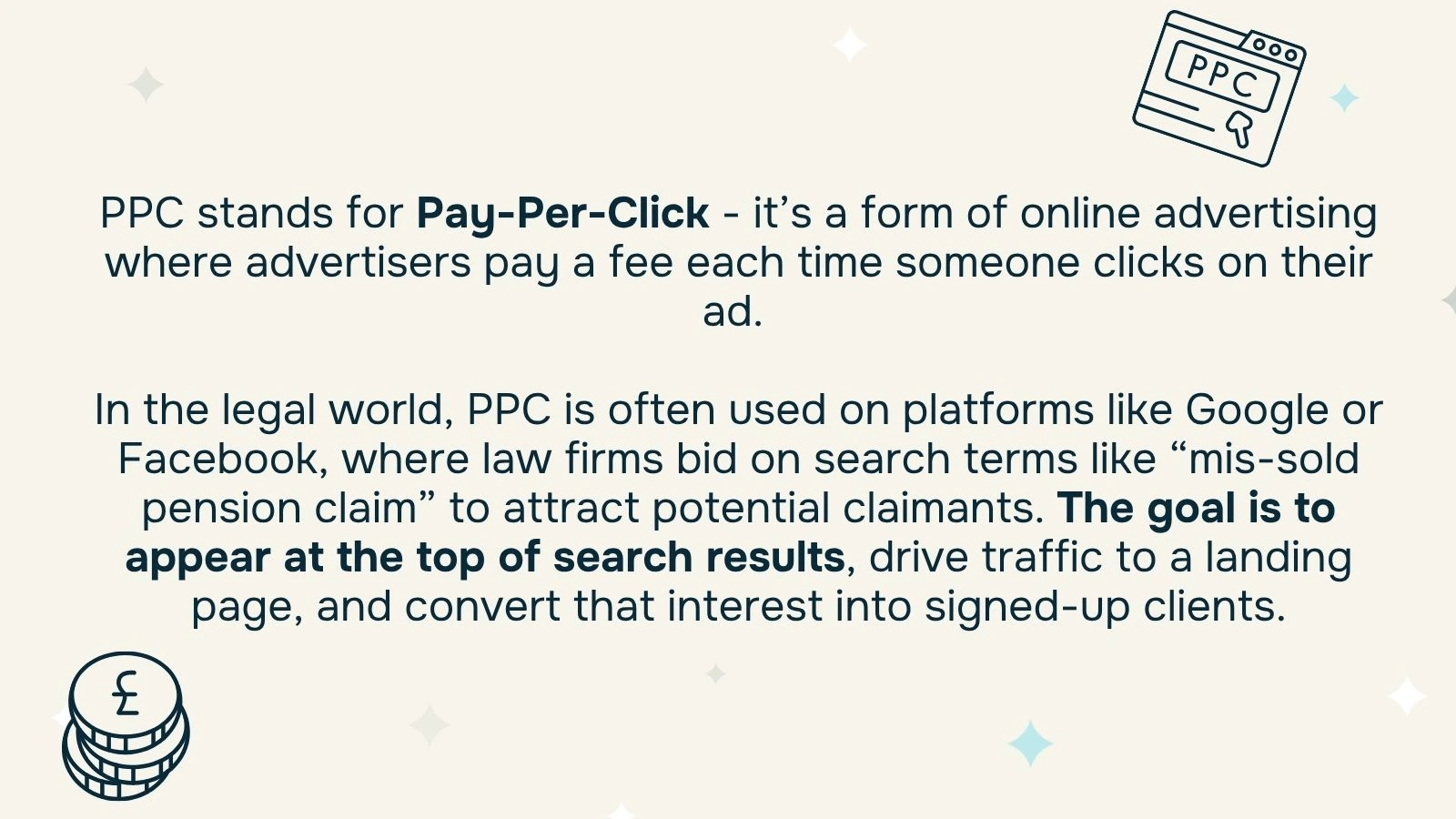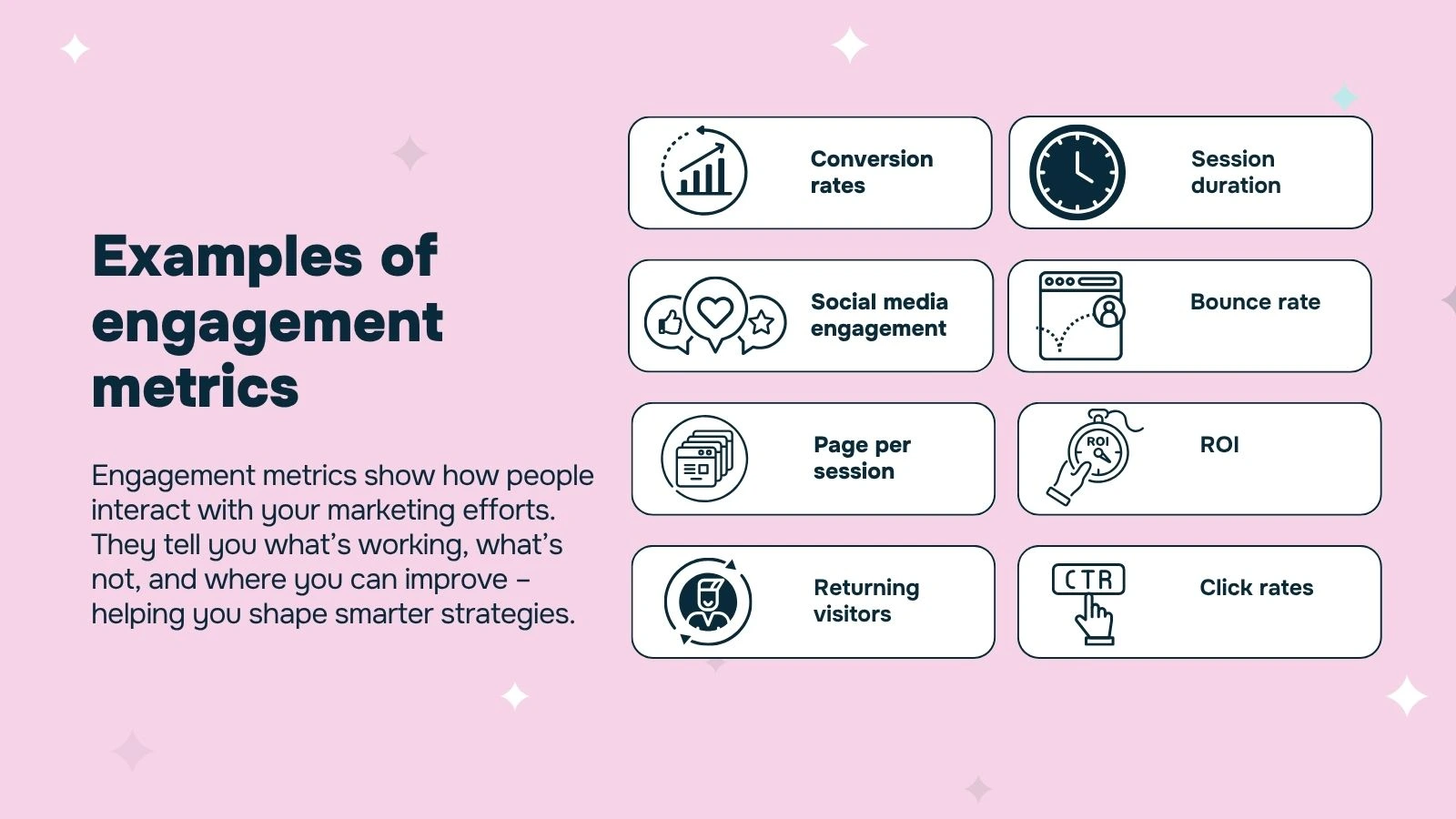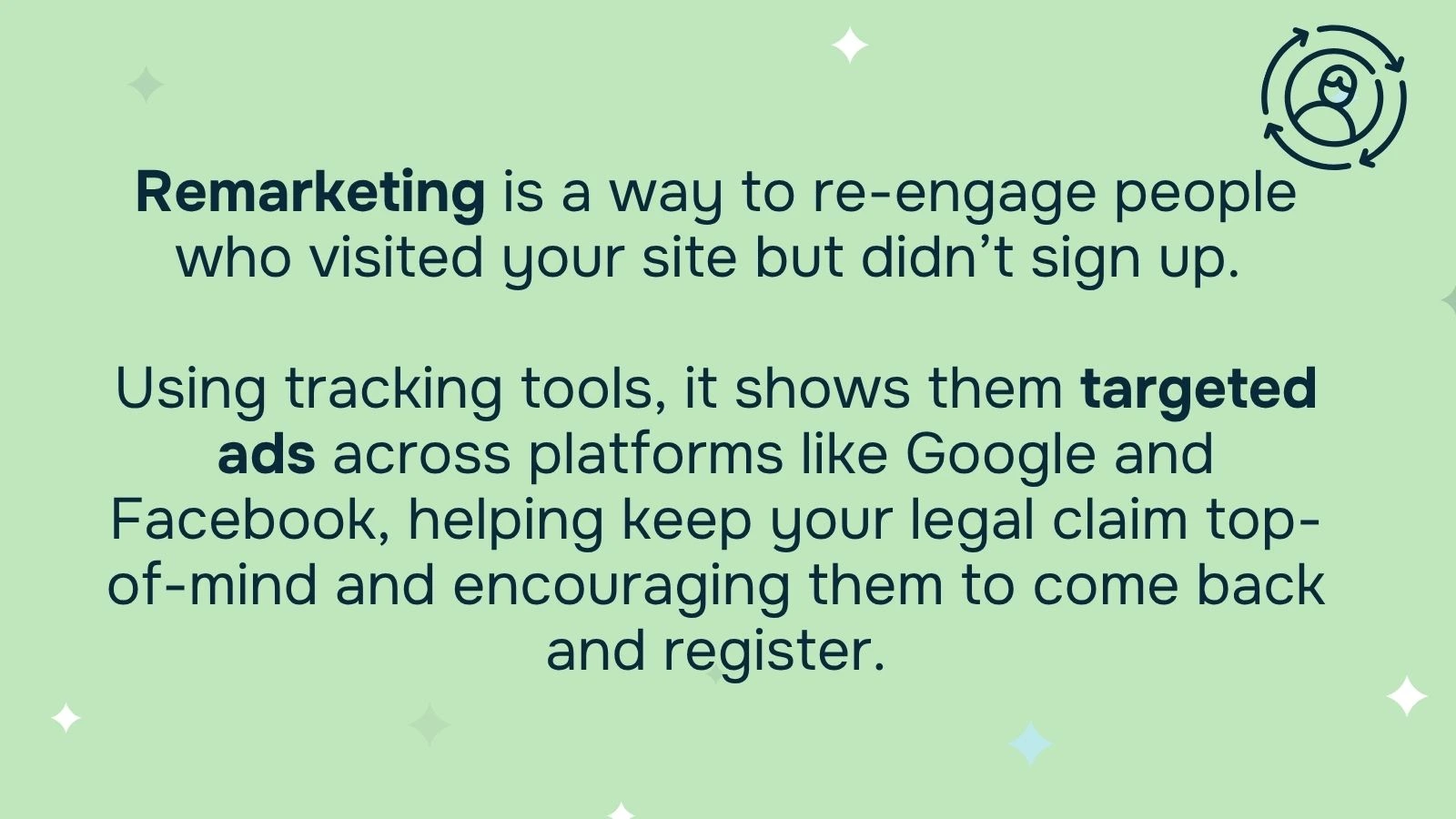
Every winning group action case starts long before negotiations begin – by capturing the interest of potential claimants. But finding the right people requires a robust engagement and onboarding process.
In this quick guide, we unpack the legal marketing funnel – how it works, why it matters, and what law firms need to know to drive sign-ups in group action claims.
The legal marketing funnel: A roadmap to client conversion
The legal marketing funnel is a strategic framework that maps out the client’s journey – from their very first encounter with your firm to the moment they engage your services.
In a space where credibility is everything, moving a potential claimant through the funnel is no small feat. Success demands a strategic blend of tactics – capturing attention, educating prospects, addressing their concerns, and ultimately onboarding.
To help, we’ve deconstructed the funnel with some practical optimisation tips.

Early stage success relies on a strategic combination of compelling content, precise SEO, and engaging advertising, all working together to ensure your law firm stands out in a crowded market.
Raising awareness in the legal claims space is a demanding task. The fast-paced nature of legal actions, coupled with a saturated market and a general unawareness among the public regarding their legal rights, creates a challenging environment for proactive outreach.
Below are some of the most significant challenges firms face when trying to raise awareness:
Firms need to be first off the mark to capture claimants before their competitors do. However, resource constraints can make it difficult to produce and promote content proactively.
Moreover, many firms are restricted from speculatively promoting potential claims, meaning by the time they launch new content, the opportunity may have already passed.
Many people are not aware they have a valid claim. Without this knowledge, they are unlikely to actively seek legal support.
Let’s face it, people don’t routinely check law firm websites to monitor for new group actions they could potentially join.
The legal claims arena is highly competitive, with many firms targeting similar keywords. Success in SEO requires either an in-depth understanding of keyword strategies or the assistance of a specialised - and often costly - SEO agency.
Deep expertise is equally critical in pay-per-click (PPC) campaigns, where sophisticated keyword research and campaign optimisation are key.

To ensure your firm is top-of-mind when legal issues surface, it’s essential to proactively attract attention, build trust, and guide potential claimants toward action. The following strategies outline practical steps law firms can take to maximise exposure, educate the public, and position themselves as trusted leaders in complex group litigation.
Develop informative blog posts, videos, and infographics that tackle common legal issues, answer FAQs, and share success stories. For instance, an article titled "What to do after the Capita data breach" can drive organic traffic from search engines and generate interest on social media platforms.
Develop a detailed content creation process that outlines how you will respond to breaking news. For example, you might not be able to launch an official claim page, but you can create a blog explaining your firm is investigating a potential claim and encourage people to sign-up for updates.
Optimise your website and content using relevant keywords (such as "data breach lawyer" and "compensation claims") to improve your search engine rankings, ensuring potential claimants can easily find your services.
Leverage platforms like TikTok, Facebook, and Google Ads to precisely target audiences based on demographics and legal needs. Use a mix of social media platforms and paid advertising to ensure your message reaches a broad audience. Tailor your approach based on platform-specific best practices to maximise engagement.
Collaborate with a third-party legal onboarding partner with established expertise and proven processes when it comes to raising awareness of group claims. As well as ensuring your firm’s message is effectively delivered to the right audience at the right time, with payment often only due on results, you get all the benefits of hiring specialist content, SEO, PPC and social media teams without any of the risks.
Once you’re on a potential claimant’s radar, you need to build trust and show them why your firm is the right one to fight their corner. At this stage, it’s all about clarity and connection – giving prospects the information they need to understand their legal options and see the true value of joining your claim.
Turning awareness into action isn’t easy. It calls for targeted, credible engagement that helps people feel confident enough to take the next step. Here are some of the key obstacles firms encounter when trying to guide potential claimants through the legal marketing funnel:
Consistently producing high-quality, engaging content requires a dedicated investment of time and resources, which can strain smaller firms or those with limited budgets.
Your expertise needs to shine through in a manner that is both authoritative and relatable to build trust and engagement. Yet legal language can sometimes come off as overly formal or technical, which may not resonate with potential claimants. Striking the right balance can be tricky.
Unless you are an established firm with a well-known reputation, it can be difficult to compete with larger firms that already command significant trust and recognition in the marketplace.
Measuring and interpreting engagement metrics can be complex. But without clear insights, it is impossible to determine which strategies are truly effective and where improvements are needed.

Prospective claimants often need reassurance, clarity, and a sense of trust before taking action. By combining user-friendly digital experiences with informative content, consistent communication, and strategic support, your firm can build stronger connections and move people from curiosity to commitment.
Each legal claim you handle should have its own dedicated landing page tailored to that specific issue. Generic messaging won’t cut through - people need to feel like you understand their situation. Think of your landing page as your digital front door - if it’s cluttered, vague, or hard to navigate, people won’t step through. But if it feels trustworthy, relevant, and easy to use, they’re far more likely to convert.
Create engaging content that explains the legal claims process, how no-win, no-fee arrangements work, and other key aspects of your service. This positions your firm as an authority and delivers immediate value to the reader.
Develop a detailed content calendar that outlines key topics, publication dates, and promotional strategies. This ensures you’re consistently delivering timely and relevant content - even when legal actions are unpredictable.
Not every visitor is ready to commit right away, and that’s okay. By offering valuable resources, like a regular newsletter with updates, insights, or case developments, you can stay on their radar. In exchange for their email, you gain a direct line to nurture trust, answer questions, and guide them toward taking action when the time is right.
Focus on gathering and showcasing client testimonials, case studies, and third-party endorsements. These “trust signals” can help establish your credibility and differentiate your firm from larger competitors. For example, a video testimonial from a client whose case was successfully resolved can significantly influence a prospect’s decision.
Implement user-friendly analytics tools to monitor engagement metrics. This data will provide valuable insights into what works and what doesn’t.
Don’t let hard-won leads slip through the cracks. By teaming up with an onboarding partner who specialises in client conversion, you tap into proven systems designed to engage, reassure, and sign up prospects efficiently. Their expertise ensures your marketing spend delivers real results - turning interest into fully committed clients.
The final stage of the funnel is where everything comes together – transforming engaged prospects into signed-up claimants. Success here depends on a smooth, intuitive process that removes friction and builds confidence, making it as easy as possible for people to take that final step and join the group action.
Conversion is often where momentum stalls. Small barriers can cause big drop-offs so it’s vital you understand what gets in the way of converting curious prospects into confident clients.
Overly complex or lengthy sign-up forms can deter prospects from completing the registration process, resulting in lost opportunities.
A lack of immediate follow-up or delayed communication can cause potential clients to lose interest or seek assistance elsewhere.
Inefficient, unclear or disjointed communication can disrupt the legal marketing funnel, leaving prospects uncertain about the next steps.
Even the most effective marketing efforts can fall short if your onboarding process creates friction or confusion. Once a potential claimant shows interest, every interaction should be designed to guide them seamlessly toward becoming a client.
Every page on your website should feature a prominent, easy-to-understand CTA that guides visitors toward the next step. Whether it’s “Join the Claim,” “Check Your Eligibility,” or “Get a Free Case Review,” the language should be direct, benefit-driven, and reassuring.
Place CTAs in strategic spots - at the top of the page, after key sections, and again near the bottom - so no one has to search for a way to engage. Clarity beats cleverness. If people don’t immediately understand what to do next, they won’t do it.
Give visitors a reason to take action by offering simple, interactive tools like eligibility checkers. These tools help users quickly understand if they might have a valid claim, and they give your firm valuable insight into lead quality. The easier you make it for someone to say “yes,” the more likely they are to move forward.
Don’t let a clunky form be the reason you lose a potential claimant. Keep your registration process clean, quick, and intuitive by cutting out unnecessary fields and only asking for what you truly need. The fewer hurdles a user faces, the more likely they are to complete the journey.
Not every lead converts on the first visit - and that’s where smart follow-up makes all the difference. Develop a structured system using emails, texts, or remarketing ads to gently nudge interested prospects back into action.
Consistent, timely communication is key to keeping prospects engaged. A good CRM system helps you manage every interaction - tracking where each lead is in the journey and ensuring nothing slips through the cracks.
Teaming up with an onboarding specialist can be a game-changer. With tested sign-up processes and a deep understanding of claimant behaviour, they help streamline the journey from interest to commitment - ensuring more prospects cross the finish line and become fully engaged clients.

Join the Claim is transforming how law firms connect with clients – combining smart digital marketing strategies and the latest tech to make group claim onboarding faster, easier, and more effective.
Here’s how we can help:
Join the Claim uses a powerful mix of content marketing, PPC, SEO, and social media to amplify your group actions. We ensure the right people see your claims, understand their rights, and are ready to take action.
As a recognised and respected name in the consumer space, Join the Claim adds credibility to your campaign - helping hesitant claimants feel confident enough to explore their eligibility and take the next step.
Our intuitive eligibility checkers let potential claimants quickly determine if they qualify for live group actions. Instant eligibility. Zero friction.
We guide eligible claimants through a streamlined, user-friendly sign-up journey. The result is higher conversion rates and a pipeline of pre-screened, committed clients delivered directly to your firm.
With advanced tech and systems already in place, we give law firms access to best-in-class onboarding infrastructure, without the time, cost, or risk of building it themselves.
Join the Claim connects law firms and funders with high volumes of qualified claimants, making group actions simpler, faster, and more cost-effective. Having built solid relationships with some of the best group litigation law firms in the UK, we’re expanding our network.
Want to learn more about how we can support your firm? Get in touch for an exploratory chat.

Mark is the product owner at Join the Claim, with over 20 years of senior leadership experience. Before joining the team, he held a key role at one of the UK’s leading providers of legal services and claims administration support – helping to deliver some of the country’s most high-profile and complex group actions.
Mark is passionate about improving outcomes for both claimants and the firms that represent them. At Join the Claim, he works closely with our legal partners to ensure their group actions are accessible, cost-effective, and built for success.

We connect consumers with their legal dream teams to ensure they get the compensation and support they deserve.
Join the Claim is not a law firm. We connect individuals with top law firms for group action claims, and our service is free to use. While we may receive a fee from the law firms we introduce you to, this will not affect your costs or compensation. We are not responsible for the advice or services provided by these firms. Please note, nothing on this website is legal advice, and while we check claim eligibility, we cannot guarantee a law firm will accept a case.
Join the Claim is a registered trading name of Big on Media ltd. Big on Media is registered in the United Kingdom under licence number 09878028 with its registered office located at Big on Media, 6 Sunderland Street, Tickhill, Doncaster, DN11 9QJ
© Join the Claim All Rights Reserved | 2025